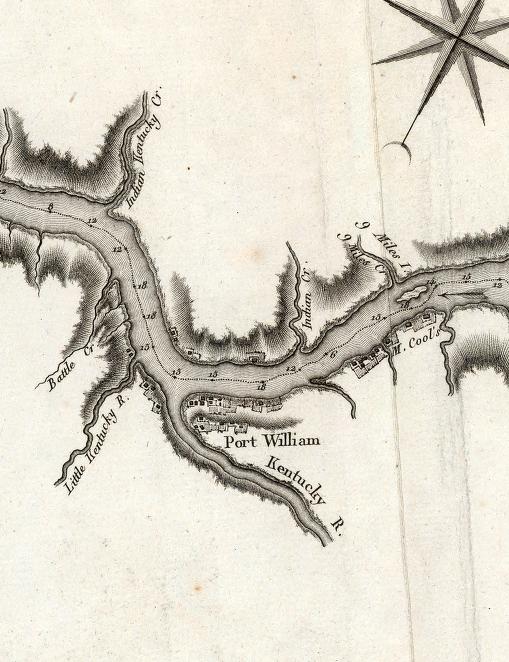One of the most glaring examples was the DAR's decision to admit Johnston/Johnson Brown of Jefferson and Switzerland County, who, it was claimed died in 1869 at 109 and was supposedly squirrel shooting at age 100. Researchers Al and Margaret Spiry demolished this--suggesting the old man was simply a good story teller. Johnson's father signed to given him permission to marry in 1795 in Nelson County, Ky., meaning he wasn't 21 years old. Do the math.
There are some other great tales. The DAR has Ralph Griffin as having died in July 1838 and buried at Springdale Cemetery. However, the Jefferson County Probate records show he died on Sept. 13, 1838 at the hosue of John Rogers (his grandson-in-law and executor) in Switzerland County. Since Rogers lived near Pleasant, and since Rogers and Ralph's wife Catherine and son David Griffin are buried at Brushy Fork Baptist Church, it's more likely his unmarked grave is there. By the way, the newspaper article about the burial said simply that a Mr. Griffin was buried in July 1838 (and Springdale was established in 1839.)
Then there was George Buchanan, whose family established Buchanan's Station, the blockhouse on the Jefferson County-Ripley County line, in 1813 according to the DAR, in 1812, according to a contemporary account.
George lived 1721-1818 according to the DAR's records; lived to be more than 100, according a newspaper article of the reminiscences of his grandson George W. in 1910, or died in 1815, according to a stone that now stands in the Buchanan family cemetery opposite the replica of the blockhouse. (It was probably moved there about 1985 from the McLaughlin Cemetery)
Many individuals have been admitted to the DAR and SAR based on the Pennsylvania Archives that show George Buchanan served from 1777 through 1781 in the Fourth Pennsylvania Continental line. The problem is, the record does not say which George Buchanan, and there are plenty to choose from in that place and time.
Now, U.S. records show that in 1786 Ezekiel and Elizabeth Buchanan, no relationship given, were paid for services of George Buchanan in the Fourth in Pennsylvania. They were paid with interest accruing from Jan. 1, 1781, which suggests the service ended on that date. The only conceivable reason someone other than the solider would be paid is that the solider, George Buchanan, had died by 1786.
Then there is Gerardus Ryker, who the DAR was Gerardus was an ensign in Col. Theunis Day's Bergen Co. Regiment, New Jersey Militia and was also an ensign in the Battalion of Major Mauritious Goetschius, New Jersey State Troops, serving extending from 1776 to 1781.
Ryker, however, moved to modern West Virginia in 1778, then to Kentucky in 1779 and was killed by Indians in that state in 1781. Based on my suggestion this didn't make since, Lynn Rogers of Dayton, Ohio, pursued this conflict and believes the Gerardus in New Jersey was a relative of the same name.
Our final problem is Samuel Welch. The DAR put a stone at his family plot on Scott's Ridge, Shelby Township, commemorating his Revolutionary service in Springer's Legion. Unfortuantely, Springer's unit served in the Indian Wars after the Revolution was over. In fact, the DAR started rejecting applicants because Samuel's initial pension application was rejected because of this fact. However, when he resubmitted his claim, it was approved. Either Samuel served as a teenager, or he was a complete liar--take your pick
Then, there's the question of his wife's maiden name. The book, "Welch and Allied Families," which was printed in 1932, carried a transcribed letter from Knox Jamison, that had been written in 1924. Jamison wrote that he checked Samuel's Bible (the one I own and that was passed down along with his farm in my family), and gave Samuel's marriage to Jane Cunningham in 1797. The Welch Book author created a nice family tree for Jane that many descendants have elaborated on, listing her parents as a John Cunningam and Ann Sinclair, who lived in Massachusetts.
There are two probems with this. The first is that some Cunningham researchers show this couple's daughter Jane, who married a Samuel Welch, died in Massachusetts. The second problem is that's not what the Bible says, and the author who transcribed Jamison's letter simply got it wrong.
The Bible shows her name as Jane Cumming (it actually looks more like Cunning, but I think that's an issue of handwriting.) There's another family Bible, one that Samuel reportedly carried with him as a soldier, that shows her name as Cummins or Cummings (the last letters are blurry.)
And this are merely lines I have investigated well. Imagine the possibilities!

